
HMCS HAIDA
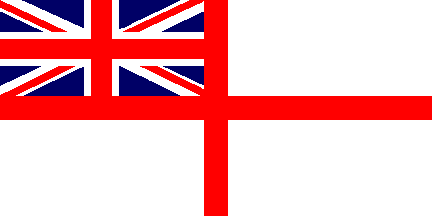

HMCS HAIDA
HMCS Haida is the last remaining example of the British Tribal Class destroyers. There were 27 built for the Royal Navy (RN), the Royal Canadian Navy (RCN) and the Royal Australian Navy (RAN) between 1937 and 1948. The Tribals were considered by some to be "magnificent in appearance, majestic in movement and menacing in disposition". They were the most advanced in naval architecture, marine propulsion and weaponry of their time.
They were the only British destroyers ever to mount eight 4.7in guns, achieved at the expense of the torpedo armament. There were 12 were lost in action during WWII. Their poor anti-aircraft armament may have contributed to the five sunk by air attack.
HMS Afridi - bombed, HMS Cossack - torpedoed,
HMS
Gurkha - sunk, HMS Maori - scuttled,
HMS Mohawk - torpedoed, HMS Nubian, HMS Zulu, HMS Ashanti, HMS
Bedouin - torpedoed,
HMS Eskimo, HMS Mashona - bombed, HMS Matabele - torpedoed,
HMS Punjabi - sunk,
HMS Sikh - sunk, HMS Somali - torpedoed, HMS Tartar
HMAS Arunta, HMAS Bataan, HMAS Warramunga
HMCS Athabaskan (I) - sunk, HMCS Haida, HMCS Huron, HMCS
Iroquois,
HMCS Cayuga,
HMCS Micmac, HMCS Nookta and HMCS Athabaskan (II)
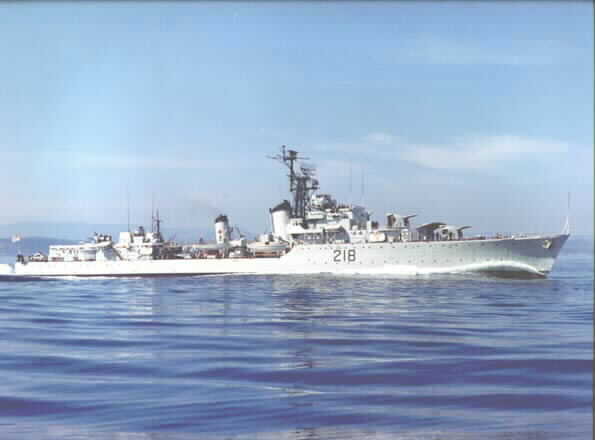
HMCS CAYUGA
The Tribal class destroyer is a British design originating in the late 1930's. The Tribals were unique as they were the first destroyers to incorporate twin gun mountings. This enhanced armament made them exceptionally powerful for their size.
The Royal Canadian Navy decided to purchase eight Tribal class destroyers in 1939. It was believed that these ships were ideally suited for patrolling Canadian waters with sufficient armament to engage commerce raiding surface vessels. Canada agreed to purchase the first four destroyers from British shipyards with the second batch of four to be built in Halifax. World War II progressed in such a way that the four British built Tribals would be used in European waters under Admiralty control with Canadian crews.
During World War II, the Tribals saw considerable action in every theatre of war from the Arctic to Okinawa and their exploits are legend in naval history. In the fall of 1943, HAIDA operated out of Scapa Flow with the Royal Navy to assist with convoy escorting duties to North Russia on the Murmansk run. On Dec 26, 1943 she was present at the Battle of North Cape, when the German battlecruiser SCHARNHORST was sunk by the British Home Fleet. Early in 1944, HAIDA joined the Tenth Destroyer Flotilla operating out of Plymouth England. This mixed force of British, Canadian and Polish warships was to clear enemy shipping off the coast of France in anticipation of the D-Day landings. During this period, HAIDA achieved great fame by destroying more enemy vessels than any other ship in the RCN. It was also during this period that her sister ship, HMCS ATHABASKAN, was sunk with the loss of 128 lives.
Following a refit in Halifax in late 1944, HAIDA rejoined the Fleet in Scapa Flow in early 1945 and spent the rest of the war operating in the Arctic and on the coast of Norway. After the surrender of Germany, the ship was overhauled to operate in the Pacific, but the war ended before her conversion was completed. In 1947, HAIDA was recommissioned into the Royal Canadian Navy and worked on the East Coast and in the Arctic. In November 1949, HAIDA was doing maneuvers off the coast of Bermuda when an American B-29 bomber went down. She was first on the scene and rescued the downed airmen. As a result, the ship's company received many letters of congratulations. The co-pilot of the aircraft was originally from Texas and for this reason, HAIDA's crew were bestowed with certificates naming them 'Honorary Texans'.
The ship operated with the Atlantic Fleet in the post-war years and in 1950 she was taken out of service for modernization and conversion to an Anti-Submarine escort with Squid mountings on her quarterdeck and improved ASDIC (sonar). HAIDA was recommissioned in March 1952. At that time, HAIDA became the first Canadian ship to be commissioned under a Queen instead of a King, thus she became known as "Her Majesty's Canadian Ship". After trials and workups were completed, she sailed almost immediately for Korea. HAIDA did two tours in Korean waters between 1952-54, on both occasions circumnavigating the globe. After Korea, the ship served in the Canadian Atlantic Fleet working mostly with NATO forces until she was paid-off and taken out of service in 1963.
The current configuration of the ship represents her conversion to a destroyer escort between 1949 and 1951. The forward 4.7 inch guns were replaced with 4 inch guns. The after 4" inch gun was replaced with a 3 inch 50 calibre gun. The after 4.7 inch mounting and the depth charge racks were removed and the squid anti-submarine mortars installed. The 20MM Oerlikons were replaced with the single 40 MM Bofors guns. The two pounder pom pom was removed and replaced with the Mark 34 radar fire control system when HAIDA went to Korea in 1952 and 1954.
HAIDA'S BATTLE HONOURS
ARCTIC 1943 - 1945
ENGLISH CHANNEL 1944
NORMANDY 1944
BISCAY 1944
KOREA 1952 - 1954
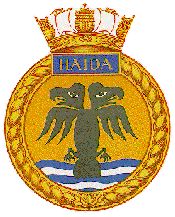
HAIDA's badge symbolizes her relationship with Canada's West Coast Indian tribe, after whom the ship took her name. The Haida Indians originally occupied thirty-nine villages on the Queen Charlotte Islands off the coast of British Columbia.
Among the many legends of the Haida Indians is one concerning a fabulous creature known as the Thunder River Bird. The HAIDA's believed that it was this bird flapping its wings which caused thunder, and that lightning flashed from its eyes. The Thunder Bird is invariably depicted with two heads. In the badge designed for Haida, a two-headed Thunder Bird is shown floating above the water. Its wings are unfolded as if they were flapping, to signify that the guns of Haida thunder across the seas.
Once, HAIDA was a mighty fighting ship. Today, she is an
irreplaceable
historic artifact representing a life style of more than a generation
of
Canadians who served in Canada's Navy between 1943 and 1963. No other
ship
was ever more deserving of the title, "The Fightingest Ship in the
Royal
Canadian Navy". Out of the 400 warships which comprised the RCN during
World War 2, only HMCS HAIDA and HMCS SACKVILLE survive today. HMCS
HAIDA
is currently located on Toronto's waterfront, soon to be repaired and
moved
to Hamilton to be the centerpiece of the Naval museum. HMCS SACKVILLE
is
in Halifax, NS.
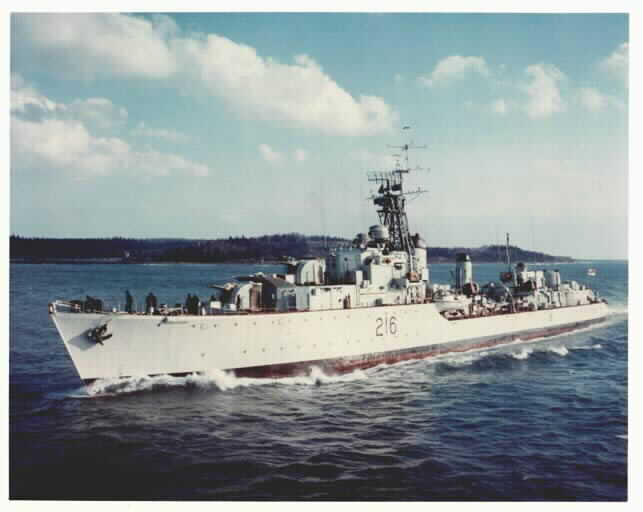
HMCS HURON
Specifications:
Original:
Displacement: 2,745 tons full load
Dimensions: 114.9M(377') x 11.4M(37.5') x 3.4M(11')
Propulsion: Parsons geared steam turbines, 2 shafts, 3 Admiralty 3
drum type boilers
Speed: 44,000 shp, 36.5 knots (max), 32 knots (service)
Crew: 259
Aviation: none
Hangar: none
Radar: none
Sonar: none
Fire Control:
Armament:
(3) 4.7" twin mounts (2 forward, 1 aft)
(1) 4" twin mount (aft)
(1) 2 Pdr. quad mount
(6) Oerlikon 20mm guns
(4) 21" Torpedoe Tubes
As DDE:
Radar: SPS-10 surface search, SPS-6 air search, Type 293, (Type 275
in 2 ships)
Sonar: Type 170, Type 174
Fire Control: Mk.6 or Mk.63
Armament:
(2) 4" twin mounts (2 forward)
(1) FMC 3"/50 Mk.33 twin mount (aft)
(4) Bofors 40mm single guns
(2) Squid ASW mortars
(4) 21" Torpedoe Tubes
Royal Canadian Navy Tribals
| Name | Pendant | Commissioned | Modernization | Paid Off | Notes |
| ATHABASKAN I | G07 | 3/2/43 | N/A | 29/4/44 | Built in Britain/Sunk 5/8/44 |
| HAIDA | G63/DDE215 | 30/8/43 | 1952 | 11/10/63 | Built in Britain/Museum |
| HURON | G24/DDE216 | 19/7/43 | 1950 | 30/4/63 | Built in Britain/Scrapped |
| IROQUOIS | G89/DDE217 | 30/11/42 | 1949 | 24/10/62 | Built in Britain/Scrapped |
| NOOTKA | R96/DDE213 | 7/8/46 | 1954 | 6/2/64 | Built in Canada/Scrapped |
| MICMAC | R10/DDE214 | 18/9/45 | 1951 | 31/3/64 | Built in Canada/Scrapped |
| CAYUGA | R04/DDE218 | 20/10/47 | 1952 | 27/2/64 | Built in Canada/Scrapped |
| ATHABASKAN II | R79/DDE219 | 20/1/48 | 1949 | 21/4/66 | Built in Canada/Scrapped |
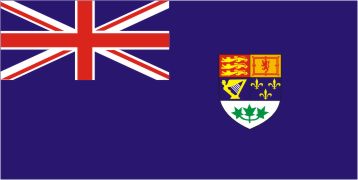
WWII CANADIAN NAVAL JACK